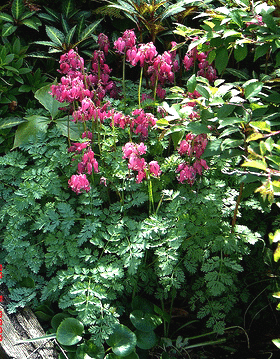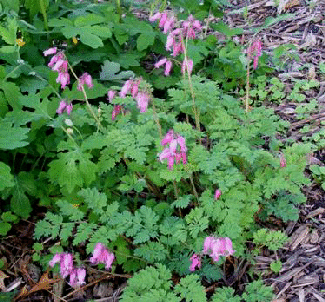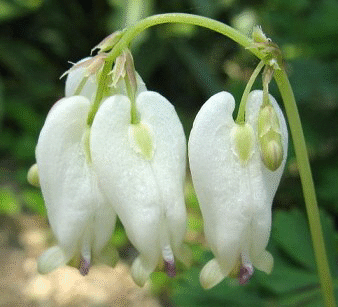Dicentra Bleeding Hearts
Dicentra Bleeding Hearts are shade garden classics
The old-fashioned bleeding hearts (Dicentra spectabilis) display the classic heart shaped blooms. Other species of Dicentra are commonly called Bleeding Hearts, but the flower form and sometimes the foliage are quite different. All however, are lovely shade plants that are easy to grow and virtually problem free. Dicentra are ideal woodland perennials that naturalize well, and are not tolerant of sun or hot and humid climates. They prefer a rich, loose, well drained soil and will not do well at all in clay soils. Wet soil may cause root rot. In a woodland garden they receive protection from early frosts and wind, so when planted in ordinary garden sites, make sure they receive the same protections. The dappled sun of a woodland garden is ideal, or just a few hours of sun, preferably morning sun. If grown in too much sun, the plant will go dormant, recede and nearly disappear when the weather gets too warm. Growth will resume in autumn or the following spring in cool weather. Some dicentra self seed quite easily, deadhead to remove the seed pods to prevent seeding. Divide every to keep the plant healthy and vigorous.
The ‘Hearts’ series are crosses generally between Dicentra eximia and perigrina intended to develop a more robust plant, and retain foliage color. The hybrids produced larger, more colorful blooms. These hybrids tend to be quite heat tolerant and may bloom all summer in northern climates. Their foliage is the bluest of all the Dicentra.
The common bleeding heart, Dicentra spectabilis, is anything but common. The classic “bleeding heart” blooms dangling along one side of a graceful arching stem is unusual and striking. The leaves are generally less dissected with large leaflets forming a delicate looking mound. The species has been a woodland garden and cottage garden favorite for many many years. It is easy to grow, very long living, and is very cold hardy. Stunning as a cut flower, it also makes an excellent container flower. Although these old fashioned bleeding hearts have been known as Dicentra for 150 years, recent genetic research has reclassified them as Lamprocaphos spectabilis. They will likely be known as Dicentra for another 150 years.
The Dicentra eximia are often referred to as the wild bleeding heart, as it is a common wildflower in north and eastern states of America. Even in the wild with no care, it blooms freely from mid spring until early autumn, but will perform even better in a cultivated garden. The creeping rhizomes will spread the plant, so it needs a little space. Dicentra eximia is the most heat tolerant of all the Bleeding Hearts.
Dicentra x ‘King of Hearts’
Common Name: Fern-leaf Bleeding Heart, Western Bleeding Heart
Plant Type: Herbaceous perennial
Height: 9-18”
Spread: 9-18”
Sun/Shade Requirements: Part shade
Water Requirements: Requires consistently moist but not wet soil, water well in hot or dry periods.
Soil Requirements: Average well drained soil, prefers enriched humusy soil.
Growth Habit: Mounded clump
Bloom Time: May to June
Bloom Color: Bright rose red
Bloom Form: Dangling heart shaped
Foliage: Blue green
Fragrance:
Pest and Disease Resistance: Nearly pest and disease free, foliage may be susceptible to leaf spot.
Fertilize: No feeding is necessary if grown in rich organic soil. Top dress with organic compost or leaf mold in spring.
Maintenance: Cut back after blooming to encourage additional blooming. Divide every six to ten years in early spring or late autumn. Delicate root balls should be lifted and handled gently.
Other: Rabbit resistant
Hardiness: Zones 5-9
‘King of Hearts is a Dicentra spectabilis hybrid, a variety in the ‘Heart Series’, is a cross between Dicentra peregrina and two Dicentra formosa subspecies, oregana and exima. The Japanese D. perigrina is difficult to grow, so the American species offers vigor and hardiness. The foliage is generally a low and wide clump of blue green ferny foliage. The foliage remains nicely fresh through the growing season, and the delicate fern like leaves are lovely. Clusters of blooms are held above the foliage on long, single, nodding stems. The primary bloom period is May through June, deadheading spent blooms promptly will encourage additional blooming through the summer. Although it generally does quite well in heat, the blooming will slow down substantially, if not stop, in the hottest period of summer. Where summers remain cool, the blooming may persist straight through summer. ‘King of Hearts’ is a sterile hybrid and will not self seed.
Use ‘King of Hearts’ in a woodland garden, or any border or bed that has at least afternoon shade. In dense shade blooming may be diminished but the foliage is lovely enough on its own. In cold zones 3 and 4, ‘King of Hearts’ will do quite well in full sun or nearly full sun with plenty of water. Hardiness in zones 3 and 4 is questionable, so select a protected site and mulch heavily for winter.
Dicentra x ‘Ivory Hearts’
Common Name: Fern-leaf Bleeding Heart, Western Bleeding Heart
Plant Type: Herbaceous perennial
Height: 8-12”
Spread: 12-15”
Sun/Shade Requirements: Part shade
Water Requirements: Requires consistently moist but not wet soil, water well in hot or dry periods.
Soil Requirements: Average well drained soil, prefers enriched humusy soil.
Growth Habit: Mounded clump
Bloom Time: May to June
Bloom Color: Ivory white
Bloom Form: Dangling heart shaped
Foliage: Blue green
Fragrance: Slightly fragrant
Pest and Disease Resistance: Nearly pest and disease free, foliage may be susceptible to leaf spot.
Fertilize: No feeding is necessary if grown in rich organic soil. Top dress with organic compost or leaf mold in spring.
Maintenance: Cut back after blooming to encourage additional blooming. Divide every six to ten years in early spring or late autumn. Delicate root balls should be lifted and handled gently.
Other: Rabbit resistant
Hardiness: Zones 4-9
‘Ivory Hearts’ is a hybrid derived from Dicentra peregrina and Dicentra eximia ‘Alba’. The Japanese D. peregrina is difficult to grow, so the American species offers vigor and hardiness. The ferny blue green foliage has a powdery surface, enhancing the blue. The foliage generally remains fresh through the growing season, forming a pretty low growing mat. Clusters of large blooms are held above the foliage on single arching stems. The primary bloom period is May through June, deadheading spent blooms promptly will encourage additional blooming through the summer. ‘Ivory Hearts’ is a sterile hybrid and will not self seed. The plant will do quite well in heat, but the blooming will slow down substantially, if not stop, in the hottest part of summer. Where summers reamin cool, the bloomin may persist straight through the summer. ‘Ivory Hearts’ is generally considered superior to ‘Snowdrift’. It is a more robust and sturdy plant, easier to grow.
Use ‘Ivory Hearts’ in a woodland garden, or any border or bed that has at least afternoon shade. In dense shade blooming may be diminished but the foliage is lovely enough on its own. In cold zones 3 and 4, ‘Ivory Hearts’ will do quite well in full sun or nearly full sun with plenty of water. Hardiness in zones 3 and 4 is questionable, so select a protected site and mulch heavily for winter.
Dicentra spectabilis ‘Alba’
Common Name: Bleeding Heart
Plant Type: Herbaceous perennial
Height: 24-30”
Spread: 18-24”
Sun/Shade Requirements: Part to full shade
Water Requirements: Requires consistently moist, but not wet, enriched soil. Water well in hot or dry periods.
Soil Requirements: Humus enriched soil, well drained. Prefers a neutral to slightly alkaline or acidic soil.
Growth Habit: Upright bushy clumps.
Bloom Time: April to May
Bloom Color: White
Bloom Form: 1” classic heart shaped blooms
Foliage: Soft green coarsely divided, lobed leaves.
Fragrance:
Pest and Disease Resistance: Nearly pest and disease free, foliage may be susceptible to aphids.
Fertilize: No feeding is necessary if grown in rich organic soil. Top dress with organic compost or leaf mold in spring.
Maintenance: Cut back after blooming to prevent self seeding. Foliage that deteriorates after bloom may be trimmed as needed.
Other: Rabbit resistant
Hardiness: Zones 2-9
‘Alba’ has pure white blooms, nonetheless displaying the classic “bleeding heart” shape. Blooms dangle in a row on one side of a long arching stem held above the foliage. Leaves emerge a bright almost lime green in spring and mature to a soft medium green. The foliage creates a beautiful ferny mound of soft green foliage. ‘Alba’ is a bit less vigorous that the pink species plant, and with somewhat diminished blooming. Even still, fresh white blooms can really brighten a shady spot. Blooms will often persist right up until the hottest part of summer, and rebloom again in autumn. The plant will generally go dormant in the heat of summer in all but the coolest regions unless it has plenty of shade and moisture. Ideally a bright dappled shade in the cool climates, and heavier shade in warm regions, particularly in the afternoon. Dicentra formosa ‘Aurora’ and Dicentra exima var. alba are both white blooming bleeding hearts that will persist better through summer, but have much smaller blooms. ‘Alba’ will self seed lightly, remove spent blooms promptly to prevent seeding. Since ‘Alba’ is a natural variant, it will come true from seed.
Dicentra eximia ‘Dolly Sods’
Common Name: Fringed Bleeding Heart
Plant Type: Herbaceous perennial
Height: 18”
Spread: 3 feet
Sun/Shade Requirements: Part shade to part sun
Water Requirements: Requires consistently moist but not wet soil, water well in hot or dry periods.
Soil Requirements: Humus enriched soil, well drained and moist.
Growth Habit: Dense spreading mound
Bloom Time: Mid spring through autumn
Bloom Color: Pink
Bloom Form: Long narrow heart shaped blooms
Foliage: Gray-blue green foliage, finely divided
Fragrance: None
Pest and Disease Resistance: Nearly pest and disease free, foliage may be susceptible to leaf spot.
Fertilize: No feeding is necessary if grown in rich organic soil. Top dress with organic compost or leaf mold in spring.
Maintenance: Cut back after blooming to prevent self seeding. Foliage that deteriorates after bloom may be trimmed as needed.
Other: Rabbit resistant, heat tolerant. Divide every 6 to 10 years in early spring to maintain the health of the plant and to propagate new plants.
Hardiness: Zones 3-8
‘Dolly Sods’ produces tight clusters of long narrow pink blooms from mid spring often until first frost. The blooms are held just above the foliage on short nodding stems. The foliage remains lovely all season, spreading slowly over the first few years to a low mounding clump.Dicentra eximia are a pretty tough and hardy Bleeding Heart, great for cold climates. ‘Dolly Sods’ will self seed fairly easily, so deadhead spent blooms promptly to minimize seeding. Blooming continues fairly freely all season, deadheading will encourage the blooming. ‘Dolly Sods’ is ideal at the edge of a woodland setting or in cottage gardens. But since it tolerates heat and a fair amount of sun, it can also be used in a perennial border, entry garden or lining a pathway. In sunny locations, be sure the soil stays moist, and in warm regions part shade is best.
Dicentra x ‘Luxuriant’
Common Name: Fern-leaf Bleeding Heart
Plant Type: Herbaceous perennial
Height: 12-15”
Spread: 12-18”
Sun/Shade Requirements: Part shade to sun
Water Requirements: Requires consistently moist but not wet soil, water well in hot or dry periods.
Soil Requirements: Prefers moist humus enriched soil, well drained
Growth Habit: Compact spreading mound
Bloom Time: May through fall
Bloom Color: Red pink
Bloom Form: Heart shaped, slightly elongated
Foliage: Gray-blue green, deeply cut foliage.
Fragrance: None
Pest and Disease Resistance: Nearly pest and disease free, foliage may be susceptible to leaf spot.
Fertilize: No feeding is necessary if grown in rich organic soil. Top dress with organic compost or leaf mold in spring.
Maintenance: Cut back after blooming to prevent self seeding. Foliage that deteriorates after bloom may be trimmed as needed.
Other: Rabbit resistant
Hardiness: Zones 3-9
‘Luxuriant’ blooms freely in spring with cherry pink heart shaped blooms, and continues throughout summer into fall. The blooms are held in clusters toward the top of long stems above the foliage. In cool climates the flowers may persist straight through the summer if soil is kept moist. In hotter regions the plant may go dormant in the heat of summer, then rebloom in autumn. ‘Luxuriant’ is fairly sun and heat tolerant, but will require consistent moisture. In hot regions part shade will benefit the plant, particularly in the afternoon. Foliage remains fresh throughout the growing season if given adequate water, forming a delicate ferny groundcover. Lineage is not known for sure, but is likely a hybrid between Dicentra exima and Dicentra formosa. It has a similar appearance to the old classic Dicentra spectabilis, but smaller overall with slightly smaller flowers and the foliage is more deeply dissected. ‘Luxuriant’ is vigorous and reliable, and very hardy, may even be hardy in zone 2. Plant in light or dappled shade, but if you can give it adequate moisture, don’t be afraid to use it in a sunny spot anywhere in your gardens.
Dicentra x ‘Aurora’
Common Name: Fern-leaf Bleeding Heart
Plant Type: Herbaceous perennial
Height: 12-15”
Spread: 12-18”
Sun/Shade Requirements:
Water Requirements: Requires consistently moist but not wet soil, water well in hot or dry periods.
Soil Requirements: Humus enriched, moist soil, well drained but not wet.
Growth Habit: Compact clump forming
Bloom Time: May to September
Bloom Color: White
Bloom Form: Heart shaped blooms
Foliage: Gray green mottled leaves, deeply dissected and fern like.
Fragrance: None
Pest and Disease Resistance: Nearly pest and disease free, foliage may be susceptible to leaf spot.
Fertilize: No feeding is necessary if grown in rich organic soil. Top dress with organic compost or leaf mold in spring.
Maintenance: Cut back after blooming to prevent self seeding. Foliage that deteriorates after bloom may be trimmed as needed.
Other: Rabbit resistant.
Hardiness: Zones 3-9
‘Aurora’ is a hybrid cross between Dicentra formosa and Dicentra eximia and is frequently referred to as a Dicentra formosa regardless of it being a hybrid. The creamy white heart shaped blooms are suspended in clusters at the top of arching stems. Blooming begins early in spring and may be in full bloom before the foliage has completely filled out. The beautiful mottled foliage is vigorous but delicate looking. The leaves are powdery blue, gray, green, giving them a mottled appearance. The Dicentra formosas are fairly tolerant of heat and humidity, but may go dormant in midsummer in hotter regions. Afternoon shade will benefit the plant in hot summers. In cool summer regions flowering may continue throughout the growing season until fall, and they may be able to do well in nearly full sun where it is cool enough if the soil is kept moist. Deadheading spent blooms promptly will encourage re-blooming and helps prevent self seeding. ‘Aurora’ is an excellent choice for the front of a woodland garden or semi-shaded perennial border. Lovely in an entry garden that is not too sunny. ‘Aurora’ is a showier more floriferous selection with larger blooms than the white bleeding heart Dicentra eximia var. Alba. Dicentra spectabilis var. Alba is also a larger and vigorous white bleeding heart, but it does tend to go dormant in summer. ‘Aurora’ is very hardy and may even be hardy to zone 2, heavy winter mulch is advised.
Dicentra spectabilis ‘Gold Heart’
Common Name: Bleeding Heart
Plant Type: Herbaceous perennial
Height: 24-36”
Spread: 18-24”
Sun/Shade Requirements: Part to full shade
Water Requirements: Requires consistently moist, but not wet, enriched soil. Water well in hot or dry periods.
Soil Requirements: Humus enriched soil, well drained. Prefers a neutral to slightly alkaline or acidic soil.
Growth Habit: Upright bushy clumps.
Bloom Time: May through June
Bloom Color: Pink
Bloom Form: 1” classic heart shaped blooms
Foliage: Golden coarsely divided, lobed leaves.
Fragrance: None
Pest and Disease Resistance: Nearly pest and disease free, foliage may be susceptible to aphids.
Fertilize: No feeding is necessary if grown in rich organic soil. Top dress with organic compost or leaf mold in spring.
Maintenance: Cut back after blooming to prevent self seeding. Foliage that deteriorates after bloom may be trimmed as needed.
Other: Rabbit resistant
Hardiness: Zones -9
The foliage of ‘Gold Heart’ is the star of this show. Brilliant golden chartreuse leaves shine in the shade. Bright pink traditional heart shaped flowers accent the large dramatic plant through spring. Long arching stems are peach colored and hold the string of hearts above the foliage. Destined to become a classic, ‘Gold Heart’ will live for years and years in your woodland garden. May self sow, deadhead spent blooms to prevent seeding.









